

Differentiated Instruction for English Language Learners. Each student comes to school, not only with unique academic needs, but also with unique background experiences, culture, language, personality, interests, and attitudes toward learning.

Effective teachers recognize that all of these factors affect how students learn in the classroom, and they adjust, or differentiate, their instruction to meet students' needs. Getting Started. Punctuation Worksheets. Free punctuation worksheets These grammar worksheets cover elementary school punctuation skills, including ending punctuation, punctuating dates, addresses and letters, commas, quotation marks, apostrophes, contractions, and colons.
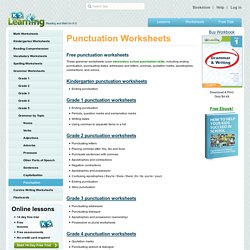
Kindergarten punctuation worksheets Ending punctuation Grade 1 punctuation worksheets. 7 Steps to a Great Writing Workshop. Would you like to make your classroom a stimulating community of writers and learners?

Set up a writing workshop! This instructional approach truly engages students by letting them write, read, interact, mentor, and take risks—all at their own pace. Follow these simple steps to create a writing workshop in your classroom. Step 1: Set up a writing workshop framework. A typical writing workshop session has four parts. 29 Shades of Grades * aux-pays-des-fleurs.com. Examples of the Assessments: Grade 3, Primary Division, 2018. G6 language reading scoring guide 2018. g3 language reading scoring guide 2018. Words in a Word. Through The Classroom Door - Learning By Design. UDL Strategies - Goalbook Toolkit. Guided Peer Discussions Guided Peer Discussions are discussions between students where the teacher provides scaffolding and specific tools to facilitate the discussion.
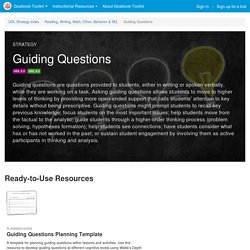
Guided Peer Discussions allow teachers to use strategies in a natural context to support student growth in communication, expression, and language discourse. Prior to Guided Peer Discussions, the teacher models specific peer discussion techniques (e.g. Academic Choice. It’s social studies time in Karen Baum’s fifth grade class and the room is humming with activity.
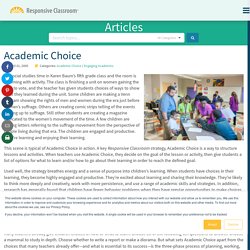
The class is finishing a unit on women gaining the right to vote, and the teacher has given students choices of ways to show what they learned during the unit. Visibility into the G Suite classroom. Timely Feedback: Now or Never. When receiving constructive feedback, learners need to know what they did well and whether their understanding is on target.
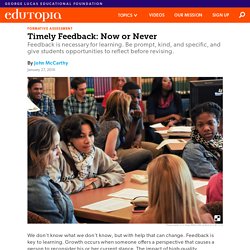
Recognizing what’s working reinforces those practices. Too often the inclination is to focus only on what’s missing or underdeveloped. These concerns do need to be addressed, but receiving the message is just as important as delivering it. Start with what’s working: This is a much kinder approach because individuals feel that their efforts are productive and their time is well spent. They become more receptive to dialogue about what skills and concepts are missing. 6 Tips for Effective 'Student-Teacher' Writing Conferences. Whether I’m teaching my unit on narrative writing, a long research paper or a quick lesson on topic sentences, teaching writing is not easy.
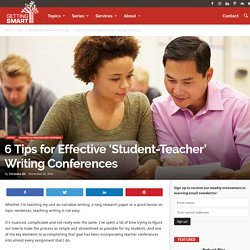
What is “Triangulation” in the Assessment Context? Triangulation. Whether conducting assessment FOR learning or assessment OF learning, a teacher must have sufficient proof of a students’ learning.
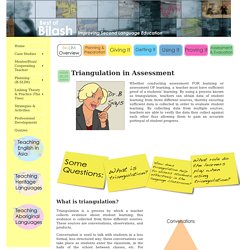
By using a process known as triangulation, teachers can obtain data of student learning from three different sources, thereby ensuring sufficient data is collected in order to evaluate student learning. By collecting data from multiple sources, teachers are able to verify the data they collect against each other thus allowing them to gain an accurate portrayal of student progress. What is triangulation? Naming What Children Can Do. Mr.
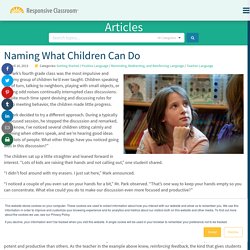
Park’s fourth grade class was the most impulsive and squirmy group of children he’d ever taught. Children speaking out of turn, talking to neighbors, playing with small objects, or making odd noises continually interrupted class discussions. Despite much time spent devising and discussing rules for group meeting behavior, the children made little progress. Mr. Park decided to try a different approach. AER Video Library - Descriptive Feedback. Environmental Education. Skip to content Ontario.ca Français Ministry of Education Home Students Parents Teachers Administrators About the Ministry News Environmental Education.
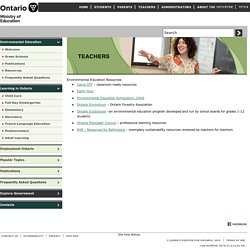
WW Teaching Ecological. Placing Music en. WW CultivateStudentEngage. Results on ReadWriteThink. Home › Results from ReadWriteThink 1-10 of 123 Results from ReadWriteThink Sort by: Classroom Resources | Grades 6 – 8 | Lesson Plan | Unit 3-2-1 Vocabulary: Learning Filmmaking Vocabulary by Making Films Bring the vocabulary of film to life through the processes of filmmaking. Students learn terminology and techniques simultaneously as they plan, film, and edit a short video. Classroom Resources | Grades 6 – 8 | Lesson Plan | Standard Lesson ABC Bookmaking Builds Vocabulary in the Content Areas V is for vocabulary.
Teaching Literacy through Music and the Arts - Resources - The Inspired Classroom. Music and Language Learning. Digital Citizenship. WW Integrated Curriculum. WW PromotingCriticalLiteracy. Critical Literacy. WW Storytelling. Promoting Literacy in Multilingual Contexts. Learning conversations. Creating Sentence Walls to Help English language Learners to Develop Content Literacy. Login - Elementary Teachers' Federation of Ontario. WW Morphology. WW Word Study. Closing the Vocabulary Gap. World of words. WW UsingDigitalTech 1. WW orthographes primaire. CBS FrenchImmersion. ELL Voices09. WW otherLanguages. WW Classroom Amplification. WW Video Games. CBS LiteracyConnected.
WW TechnologyTools. WW StudentFilmakers. Iepresguid. ESL math. Comprehension Toolkit Series for Nonfiction Reading Comprehension. Grades K-6. What’s New in the Second Edition? The new 2016 edition of the series includes everything from the original edition plus a new teacher’s guide, new online resources, and a new book, Content Literacy: Lessons and Texts for Comprehension Across the Curriculum; many new lessons integrate the strategies with science and social studies curriculum. Strategy and Lesson Books: The updated strategy books contain the same content and lessons from the original edition with an improved design and organization to make the teaching of comprehension more accessible and easier to integrate across the curriculum. 5 Ways Teachers Can Create a Translanguaging Classroom – Little Sponges. What is Translanguaging? Interview conducted by François Grosjean In the last ten years or so, a new term has appeared in the field of bilingualism, most notably in the area of bilingual education - translanguaging.
One of its most visible proponents is Professor Ofelia García of the Graduate Center of the City University of New York. Sometimes its the Little Things Resource Booklet.pdf. Sometimes its the Little Things Resource Card Deck.pdf. Evidence Mindfulness education in schools has been increasingly supported based on the evidence linking it with an. Climate for Learning and Working in Action. Functional Language ESL Activities Worksheets Games. Learning functional language gives students of English the skills to communicate effectively in various everyday situations.
Functional language contains a lot of fixed expressions. Login - Elementary Teachers' Federation of Ontario. Safe @ School. Storyline Online. Teaching Elementary ESOL Students through the Silent Period. Learn.etfo-aq.